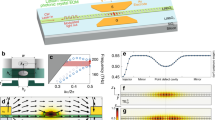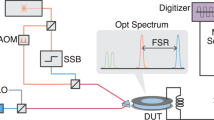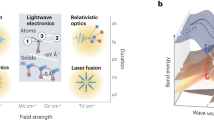Abstract
Photonic and optoelectronic devices may offer the opportunity to realize efficient signal processing at speeds higher than in conventional electronic devices. Switches form the building blocks for circuits, and fast photonic switches have been realized1,2,3,4,5,6. Recently, a proof of principle demonstration of exciton optoelectronic devices was reported7,8. The potential advantages of excitonic devices include high operation and interconnection speed, small dimensions and the opportunity to combine many elements into integrated circuits. Here, we demonstrate experimental proof of principle for the operation of excitonic switching devices at temperatures around 100 K. The devices are based on an AlAs/GaAs coupled quantum well structure and include the exciton optoelectronic transistor (EXOT), the excitonic bridge modulator (EXBM), and the excitonic pinch-off modulator (EXPOM). A two orders of magnitude increase in the operation temperature compared to earlier devices (1.5 K; refs 7,8) is achieved.
This is a preview of subscription content, access via your institution
Access options
Subscribe to this journal
Receive 12 print issues and online access
$209.00 per year
only $17.42 per issue
Buy this article
- Purchase on Springer Link
- Instant access to full article PDF
Prices may be subject to local taxes which are calculated during checkout





Similar content being viewed by others
References
Liu, A. et al. A high-speed silicon optical modulator based on a metal-oxide-semiconductor capacitor. Nature 427, 615–618 (2004).
Xu, Q., Schmidt, B., Pradhan, S. & Lipson, M. Micrometre-scale silicon electro-optic modulator. Nature 435, 325–327 (2005).
Jiang, Y., Jiang, W., Gu, L., Chen, X. & Chen, R. T. 80-micron interaction length silicon photonic crystal waveguide modulator. Appl. Phys. Lett. 87, 221105 (2005).
Green, W. M. J., Rooks, M. J., Seekaric, L. & Vlasov Y.A. Ultra-compact, low RF power, 10 Gb/s silicon Mach–Zehnder modulator. Opt. Express 15, 17106–17113 (2007).
Liu, J. et al. Waveguide-integrated, ultralow-energy GeSi electro-absorption modulators. Nature Photon. 2, 433–437 (2008).
Chen, H. W., Kuo, Y. H. & Bowers, J. E. High speed hybrid silicon evanescent Mach–Zehnder modulator and switch. Opt. Express 16, 20571–20576 (2008).
High, A. A., Hammack, A. T., Butov, L. V., Hanson, M. & Gossard, A. C. Exciton optoelectronic transistor. Opt. Lett. 32, 2466–2468 (2007).
High, A. A., Novitskaya, E. E., Butov, L. V., Hanson, M. & Gossard, A.C. Control of exciton fluxes in an excitonic integrated circuit. Science 321, 229–231 (2008).
Miller, D. A. B. Rationale and challenges for optical interconnects to electronic chips. IEEE 88, 728–749 (2000)
Wakita, K. Semiconductor Optical Modulators (Kluwer Academic Publishers, 1998).
Hagn, M., Zrenner, A., Böhm, G. & Weimann, G. Electric-field-induced exciton transport in coupled quantum well structures. Appl. Phys. Lett. 67, 232–234 (1995).
Butov, L. V. & Filin, A. I. Anomalous transport and luminescence of indirect excitons in AlAs/GaAs coupled quantum wells as evidence for exciton condensation. Phys. Rev. B 58, 1980–2000 (1998).
Larionov, A. V., Timofeev, V. B., Hvam, J. & Soerensen, K. Interwell excitons in GaAs/AlGaAs double quantum wells and their collective properties. Sov. Phys. JETP 90, 1093–1104 (2000).
Butov, L. V., Gossard, A. C. & Chemla, D. S. Macroscopically ordered state in an exciton system. Nature 418, 751–754 (2002).
Vörös, Z., Balili, R., Snoke, D. W., Pfeiffer, L. & West, K. Long-distance diffusion of excitons in double quantum well structures. Phys. Rev. Lett. 94, 226401 (2005).
Gartner, A., Holleithner, A. W., Kotthaus, J. P. & Schul, D. Drift mobility of long-living excitons in coupled GaAs quantum wells. Appl. Phys. Lett. 89, 052108 (2006).
Ivanov, A. L., Smallwood, L. E., Hammack, A. T., Sen Yang, Butov, L. V. & Gossard, A. C. Origin of the inner ring in photoluminescence patterns of quantum well excitons. Europhys. Lett. 73, 920–926 (2006).
Chemla, D. S., Miller, D. A. B., Smith, P. W., Gossard, A. C. & Wiegmann, W. Room temperature excitonic nonlinear absorption and refraction in GaAs/AlGaAs multiple quantum well structures. IEEE J. Quantum Electron. 20, 265–275 (1984).
Makino, T., Segawa, Y., Kawasaki, M. & Koinuma, H. Optical properties of excitons in ZnO-based quantum well heterostructures. Semicond. Sci. Technol. 20, S78–S91 (2005).
Segal, M., Singh, M., Rivoire, K., Difley, S., Van Voorhis, T. & Baldo, M. A. Extrafluorescent electroluminescence in organic light-emitting devices. Nature Mater. 6, 374–378 (2007).
Zrenner, A. Festkörperprobleme/Advances in Solid State Physics. Vol. 32, p. 61 (Vieweg, Braunschweig, 1992).
Miller, D. A. B. et al. Electric field dependence of optical absorption near the band gap of quantum-well structures. Phys. Rev. B 32, 1043–1060 (1985).
Remeika, M. et al. Localization–delocalization transition of indirect excitons in lateral electrostatic lattices. Phys. Rev. Lett. 102, 186803 (2009).
Butov, L. V., Zrenner, A., Abstreiter, G., Böhm, G. & Weimann, G. Condensation of indirect excitons in coupled AlAs/GaAs quantum wells. Phys. Rev. Lett. 73, 304–307 (1994).
Hammack, A. T. et al. Excitons in electrostatic traps. J. Appl. Phys. 99, 066104 (2006).
Acknowledgements
This work was supported by ARO and NSF.
Author information
Authors and Affiliations
Contributions
All authors contributed to the work presented in this paper.
Corresponding author
Supplementary information
Rights and permissions
About this article
Cite this article
Grosso, G., Graves, J., Hammack, A. et al. Excitonic switches operating at around 100 K. Nature Photon 3, 577–580 (2009). https://doi.org/10.1038/nphoton.2009.166
Received:
Accepted:
Published:
Issue Date:
DOI: https://doi.org/10.1038/nphoton.2009.166
This article is cited by
-
A framework for multiexcitonic logic
Nature Reviews Chemistry (2024)
-
Room-temperature high-speed electrical modulation of excitonic distribution in a monolayer semiconductor
Nature Communications (2023)
-
Zero-field quantum beats and spin decoherence mechanisms in CsPbBr3 perovskite nanocrystals
Nature Communications (2023)
-
Electrical control of hybrid exciton transport in a van der Waals heterostructure
Nature Photonics (2023)
-
All-optical control of high-purity trions in nanoscale waveguide
Nature Communications (2023)



